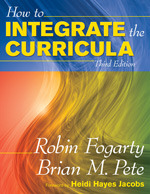How to Integrate the Curricula
- Robin J. Fogarty - Robin Fogarty & Associates, Ltd.
- Brian M. Pete - Robin Fogarty & Associates, Ltd.
Foreword by Heidi Hayes Jacobs
Instructional Leadership | Standards & Accountability | Teaching Methods & Learning Styles
"This book should make educators stop and consider exactly what they mean when they discuss curriculum integration."
—Julie Prescott, Assessment Coordinator
Vallivue High School, Caldwell, ID
"The biggest strength of Fogarty's work is its clear, concise organization centered on the guiding questions of each chapter."
—John C. Baker, Eighth-Grade Social Studies Teacher
Salem Middle School, Apex, NC
Strategies for moving students towards more holistic and authentic types of learning!
For both students and teachers, the mission is essential: to connect ideas, discern themes, and thread skills of various content areas into a cohesive whole. Yet, the question remains: "What does integrating the curricula really mean?" The answers are provided in this updated resource that helps teachers create brain-compatible, learner-centered classrooms and better prepare students for lifelong learning.
Based on a four-pronged rationale for using an integrated curriculum—including findings from brain-based research, parental concerns, practitioner challenges, and student perspectives—Robin Fogarty offers ten models that allow teams of teachers to work together to group elements from various content areas into a coherent curriculum that effectively meets standards. The discussion of each model includes:
- A description of the model
- How the model can be applied in the classroom
- Benefits and challenges of the model for teaching and learning
- Guidelines for when and how to implement the model in the classroom
- A wealth of reproducibles to aid implementation
How to Integrate the Curricula offers the support educators need to integrate concepts, skills, and attitudes and immerse students in content through self-selected, personally relevant learning experiences.
"The biggest strength of Fogarty’s work is its clear, concise organization centered on the guiding questions of each chapter."
"This book should make educators stop and consider exactly what they mean when they discuss curriculum integration."
